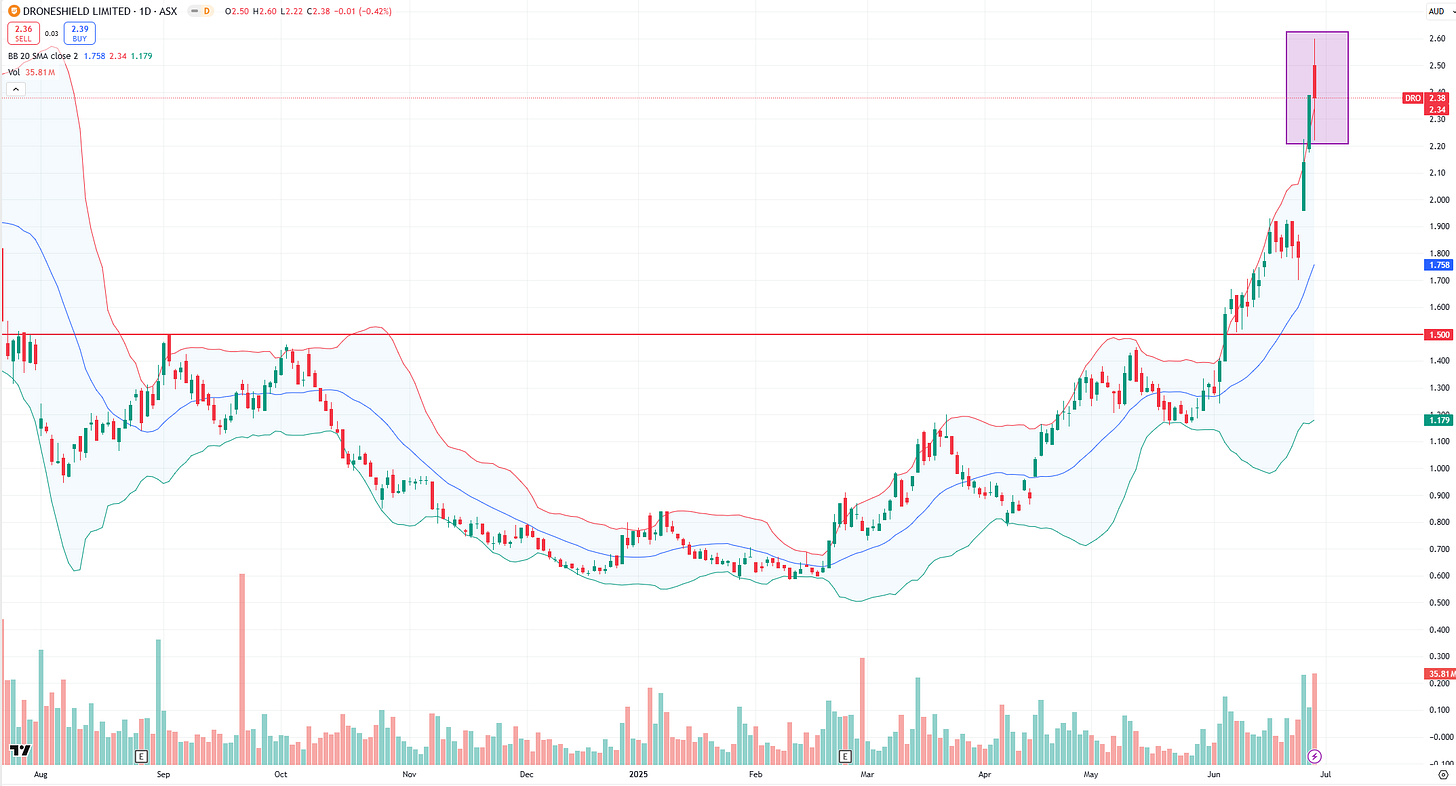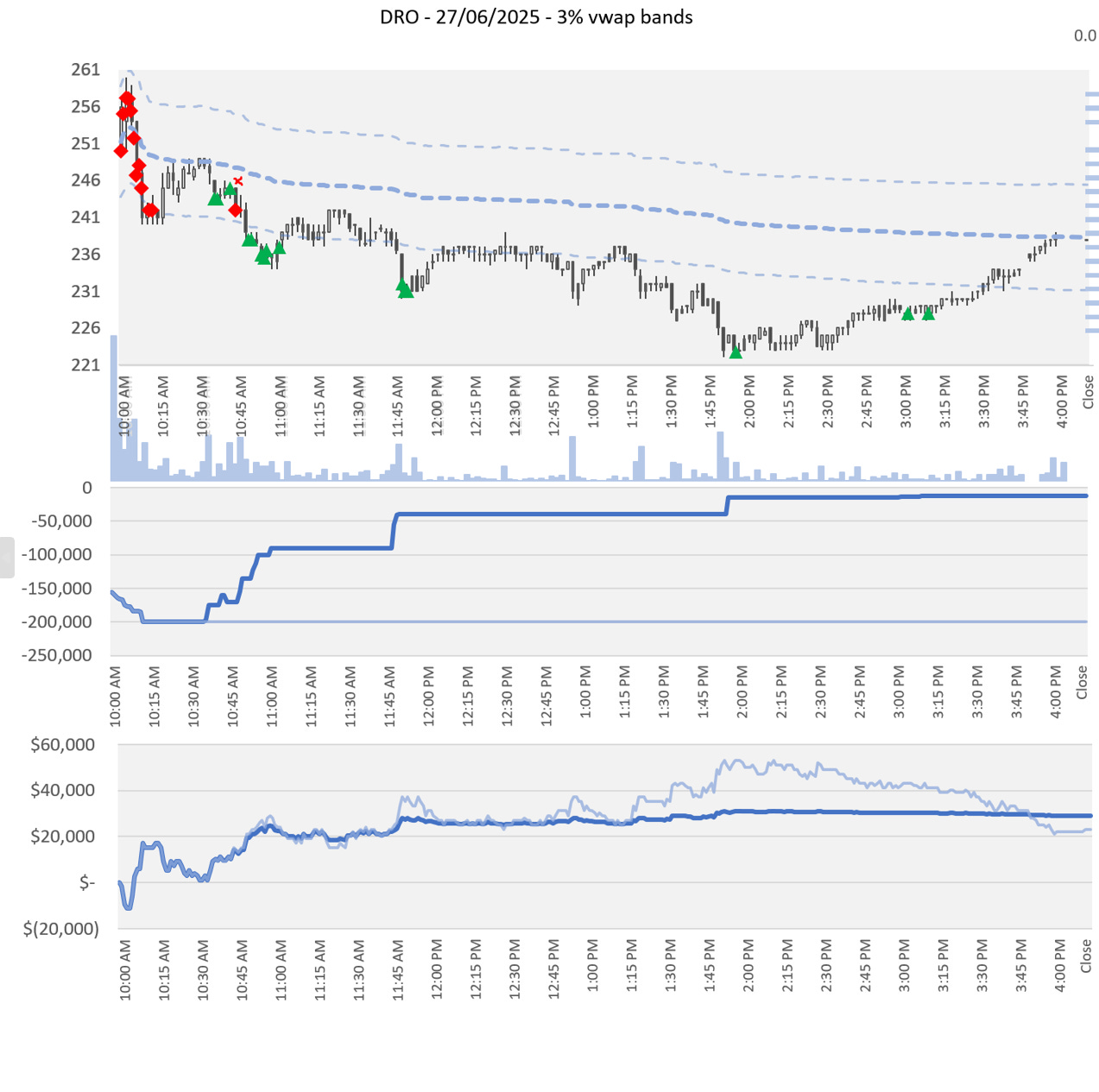Traders are always searching for the next big opportunity, yet sometimes it appears right under your nose.
The “parabolic short” setup in CRCL was all over trading Twitter last week. It seemed to be a textbook blow-off top that had everything: a vertical daily chart, massive volume, full float rotation, Cathie Wood participation, and the kind of hyped-up narrative (think Lithium, Weed, AI, and now Blockchain) that fuels speculative runs before they unravel. It grabbed me so fully that I ended up watching late into the night from down under.
However, many were left frustrated with the nature of the turn lower in the first two days. It wasn’t idealised or clean, and led to frequent traps for the shorts.
Meanwhile, in Australia, a comparable opportunity materialised almost from nowhere.
Different markets, different setups, but many of the same nuances and principles apply.
Don't get me wrong, I think it is really important to do the work and experiment with alternative markets or sources of edge. The challenge is walking the line between chasing a new shiny toy - often at the cost of disrupting your core routines such as sleep - and the quiet compounding effect of focusing on what’s already in your zone and doing it better. I don’t know the right answer here.
As mentioned in the past, it was reading the report cards of Lance Breitstein in the US that fascinated me in the parabolic setup. Many of the intraday intricacies were not prevalent in my market, but I reverse-engineered the several important variables that showed up time and time again1. This was all improved by the help of a team.
One of the best recent breakdowns on the topic came from Bracco (@Braczyy), who published a brilliant in-depth piece on his Substack, Uncharted Territory. I highly recommend reading it here.
Although no two setups are ever the same, the DRO short on Friday in Australia displayed many common traits.
It is this trade that I now turn to.
The Parabolic Burst
The common denominator among all capitulation tops is the parabolic burst.
Bracco defines a list of criteria for a stock’s move to qualify:
Three straight days of gains
Two consecutive overnight gap-ups
Two out of three days of range expansion
Two days of volume expansion
A gap-up on the climax day
Not every element needs to be satisfied, but as with most setups, the more factors that align, the stronger the hand.
Interestingly, the one major variable that was missing in the CRCL event was “a gap-up on the climax day”. It is this gap that creates a vacuum below as the new money chasing even higher prices gets trapped if the stock fails to follow through. Instead, on Monday, the CRCL opened flat and trended cleanly to $300 before putting in its intraday reversal.
I am not suggesting that DRO was a parabolic move of this nature, as the backdrop is very different. It was a breakout on fresh earnings. However, it did share many of these same features:
→Two consecutive overnight gap-ups
→Two days of range expansion
→A gap-up on the climax day
And these are some of the important criteria for me to trade for a mean-reversion system.
Let’s dive into the trade write-up, how I executed, and what I can improve for next time. There are elements that you may find useful for your trading, and to better frame these structures for next time.
DRO Gap-Up fade 27/6/25
What I liked about the trade:
Strong open-to-close move the prior day. The stock also ticked up from $2.34 to $2.39 in the closing match!
Extension from short-term averages
Consecutive closes outside the Daily Bollinger band
New gap up of 4.5%
An A rating for my system
What I didn’t like about the trade
The move is happening on a fundamental re-rate with a very strong contact win and broker revisions higher.
Prior day positive news and sentiment coming out of NATO, which confirmed 5% spend on defence
The go-to exposure name in the strongest sector theme in the Australian market i.e. drones and defence spending.
However, the whole point of having a system is to discount these variables and provide structure. I never fade Day 1 but instead am looking for the move to filter in price AND time.
The Trade:
One of the most important features of a trade write-up should be specifics.
The whole point of doing this work is to internalise patterns, nuances, and lessons to build the necessary neural pathways to improve performance in real time for the next one. It trains the unconscious. Less narrative and more real information.
Here are some of the major inflection points:
→The Gap-Up
The stock gapped 4.6% to 2.50 on 2.2m shares. This is the necessary condition, post a run-up, for potential exhaustion. It is the sign that sentiment is reaching a fever pitch. What made this even more interesting is that the stock spiked to 257 instantly. Everyone who bought that open is now making money and feeling good. How do you think these same participants would feel if they saw these gains evaporate should the stock break back down through 2.50?
In fact, 5.4m shares or $13.7m traded at 2.50 or better in the early going. That is a lot of money coming into the stock at higher prices.
→The Break of 2.50 creates a vacuum
The early major prints were into the bid. The 2.55 bid was hit for 141k or 3% of volume at 10:03 am; the 2.52 bid was hit for 170k soon after. Volume into the bid is bearish.
By 10:04 am, the book was offered over at 2.50 with a real seller. All the early gains had vanished. A real player was happy to take profits or go short. There was little protection until down at 2.46, which was again hit in one go for 200k. Volume into the bid is bearish.
Everyone who bought stock early is now losing money.
→The Break of 2.40 creates a second vacuum
The flush through 2.50 into 2.40 was sharp, and a sizeable bid held. This became a major inflection point with solid support. The stock would flick up on lighter volume and even retest the 2.50 prior breakdown BUT it couldn’t hold back above.
It was the 2nd major test of this 2.40 level that triggered a fresh breakdown leg and a trend tade for the rest of the day.
Indeed, the see-it moment was the breakdown bar on volume into and through 2.40 at 10:47 am. It is worth replaying this moment.
How did I trade it?
I committed to my entry rules and shorted some on open, some vwap, and more on the confirmed breakdown through 2.50. This did not feel comfortable in the early going, but that is exactly how some of the best mean reversion trades are meant to feel. The spike to higher prices actually creates a higher EV if focusing on the bigger picture setup.
Importantly, the stock turned down relatively quickly, which confirmed the trade. You can’t hang around here if you see unusual strength - this is blow-up potential in strong names.
The inability to drop 2.40 in time was an initial cause for caution. Seeing my profit completely reverse was certainly on the back of my mind. Given this, I did cover some on the first major retest of support. I knew this was instantly the wrong thing to do, so I hit some back out. From here, I tried to focus on exit rules by covering 1/2 into time + extension, and the rest holding a core to the close.
Better?
The major improvement could have been to use the restets of the 2.40 zone to add to the position. We are now in a confirmed backside move; all volume has been into the breakdowns; new longs are all underwater; and this opens up the potential for a bigger move.
The exits were solid but rather fortuitous. Once the stock held below 2.40, I committed to holding 1/2 position to the close as per my rules. I set an algo starting at 3 pm. However, the sharp dumps offered a chance to lighten up in optimal spots. I am still too quick to lock in a large % of my holdings on fast dumps.
Conclusion:
No setup ever plays out exactly the same.
The DRO trade didn’t feel obvious ahead of time, but it carried enough familiar elements and variables to act upon.
And that’s the real edge: doing the work, learning to trust the work, staying present in what you are seeing in the moment, and letting experience shape your instincts.
I will learn enormous lessons from CRCL, just as I did from DRO.
Let me know if you traded CRCL and how you went? I am intrigued.
Thanks
Austin
—————————————————————————————
If you liked this post and want to gain access to more in-depth trade write-ups and premium content, consider a subscription here:









Thanks Austin, you laid this out perfectly.
Really enjoyed this, thanks Austin